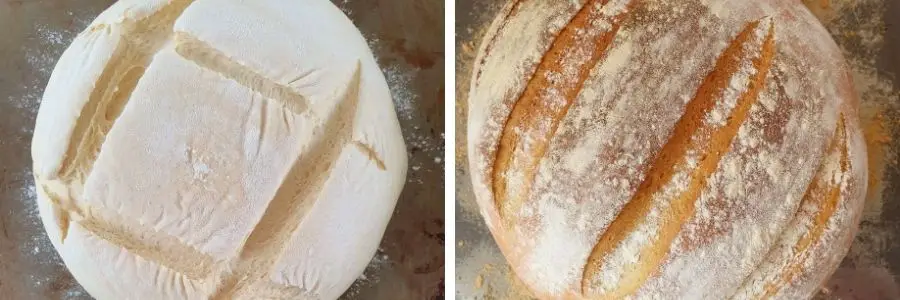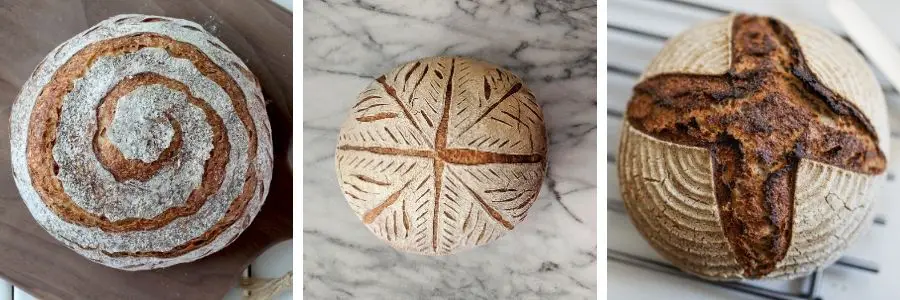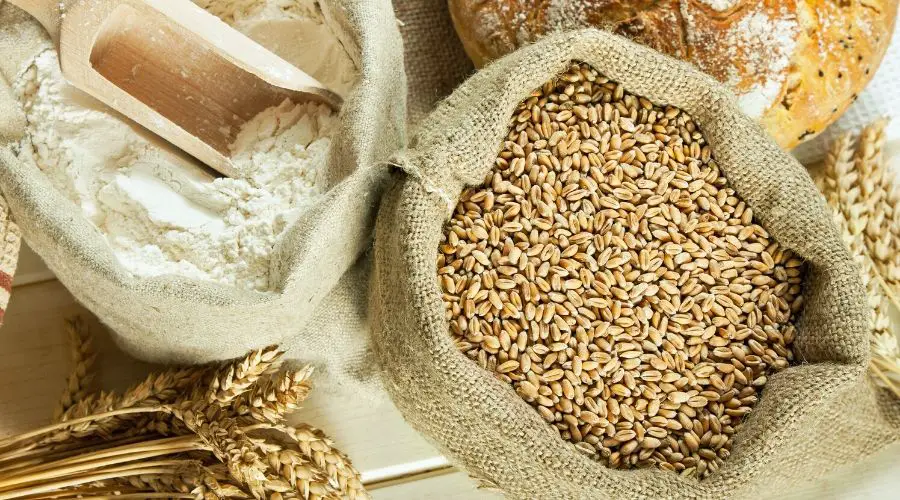Proving or proofing bread dough correctly is one of the most important bread-making steps to achieving a well-risen bread with a good crumb texture.
Learning how to identify if bread dough is proved enough and not over-proved is a key skill which will help bread-makers produce perfect bread every time.
In this post, I want to show you everything we, as home bakers need to know about proving bread, including how long to prove dough, proving temperature and various proving techniques.
As well as this, I’ve also added a link to my YouTube video where I tested and baked dough which was under-proved, proved enough and over-proved.
So, what is proving (or proofing)?
Proving which is also known as proofing is the process where the dough is rested to allow the yeast to ferment and produce gas bubbles which help the dough to rise.
Most bread recipes will require the bread dough to rise twice, the first time after kneading and again after the dough has been risen for the first time and then shaped.
The term ‘proving (or proofing)’ is generally used to describe the second rise of the dough, although you may see some bakers also describing the first rise as a prove.
This can be one of the more confusing aspects of bread making when new bakers start out.
What happens during dough fermentation?
The fermentation process is first activated when water is added to flour and yeast and gluten starts to develop. Kneading the dough at this stage helps to create a strong inner structure which supports the dough as it rises.
The yeast begins to feed on the carbohydrate in the flour and produces carbon dioxide which gets trapped between the gluten strands and causes the dough to rise as it’s left to rest.
The yeast also creates other byproducts such as alcohol and yeast, which all help to create flavour and the longer the dough is allowed to ferment the more flavoursome it will become.
Why does bread dough need to rise twice?
Bread dough needs to rise twice if the bread you’re looking to create needs to rise high, for example, a tin or sandwich loaf needs as much rise as possible to be the right shape.
Dough for flatbread, pizza and breadsticks doesn’t normally need to prove for a second time because the bread style is designed to be flat.
During the second prove the yeast gets another chance to prove its ability to cause fermentation which helps to create structure and the right crumb texture for risen bread. Longer fermentation also helps extra flavour to develop.
TIP: Not sure if you have all the necessary bread baking equipment at home? Check out my recommended picks below (Amazon links):
-
- Scale: Nicewell 22lb Digital Kitchen Scale
- Mixing Bowls: OXO Stainless Mixing Bowls Set
- Pastry Scraper: OXO Stainless Pastry Scraper
- Loaf Pan: OXO Non-stick Loaf Pan
- Kitchen Thermometer: ThermoPro Digital Thermometer
- Stand Mixer (optional): Kenwood Kmix Stand Mixer
How long should you prove bread dough for?
Most recipes state that you should allow a first rise time of an hour and another hour for the second prove. In reality, this is probably not the case. If I was to keep a note of every time I’d allowed for rising (which I might start doing), the rise time is probably nearer to the two-hour mark.
This really depends on a number of factors which I’ll cover next, but if you’re rising at normal room temperature, chances are the dough will take longer than an hour to prove.
The key is to make sure the dough has increased in size, by either double or even triple the original size.
For the first rise, you can get away with proving for longer, whereas for the 2nd rise it’s more important to make sure the dough doesn’t under or over prove.
Allowing the dough to ferment slowly generally leads to taster bread with a good structure.
Artisan bread such as sourdough is allowed to slowly ferment over a long period of time which is what helps to create the unique sourdough flavour.
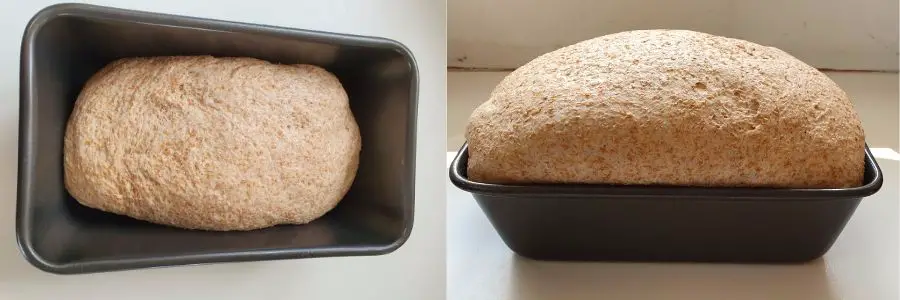
Factors which may affect proving time
| Factor | How it affects proving time |
| Protein in bread flour | Strong flour with a higher protein level (over 12%) will produce more gluten and therefore a stronger structure. More protein also allows the flour to absorb more water leading to a better bread structure. Some brown flour containing the wholewheat grain may also take longer to prove as they’re more weighty. |
| Ingredient temperature | If the water used in the dough mix is warm this will make the yeast more active and increase the fermentation, this is not always a good thing and it’s good to use ingredients at around room temperature. |
| Room Temperature | If the room is very cold this can lead to a very sluggish rise whereas a very warm room will lead to a very fast rise. |
| Yeast type and performance | A fast-acting dried yeast will generally produce faster fermentation and rise than fresh yeast. Yeast which is old or stale if it’s not been stored properly can underperform and take a long time to ferment – if at all. |
| Other bread ingredients | The addition of other ingredients can affect how the dough rises because can be weighed down. Other factors such as water and sugar content can also, make a difference to the rise. |
Why does sourdough take so long to rise and prove?
The reason many bakers use dried yeast is because it’s fast-acting and easy, you can have a loaf within 3 or 4 hours if proved in a warm room and it’s done.
With sourdough, the fermentation process is much slower and it’s this slow rise that creates the unique sourdough flavour.
Instead of yeast sourdough is made using a starter which is made by creating fermentation in flour and water. It can be a tricky process and each starter is unique and will perform at a different level depending on how its made.
Sourdough can take a whole day to make or even beyond and its for this reason that artisan bread generally comes at a premium.
What happens if you under-prove bread dough?
Under-proving dough means that it’s not given enough chance to rise to its full potential, so the end result is likely to be a flat dense loaf with a poor crumb structure.
Under-proved bread has a very tight crumb structure which clumps together when squeezed, whereas bread which is proved well has a good bounce and will spring back when squeezed.
There is no specific time for dough to become properly proved, so the danger is that you follow a recipe which says to prove for an hour and other factors such as a cool room temperature mean the dough needed two hours to rise.
It’s for this reason that checking if dough is fully proved is best done by eye and touch. This is also something which comes with a little bit of bread making practice and experience.
What happens if you over-prove bread dough
Over-proving bread dough will lead to bread which is very airy and fluffy and large air bubbles which will lead to holes in the bread.
If the dough is allowed to prove for a long time, it will begin to collapse back in on its self because the dough can’t go on supporting all of the gas which is being produced.
It’s a bit like blowing up a balloon, you can only blow it up to the point which can be supported by the balloon structure before it pops and releases the air.
Dough which is a little over-proved isn’t too much of a problem, it will just mean the structure is a little different to normal. It will still be fine to bake and will taste just as good.
On the first rise, this isn’t a major issue because you’re going to be rising the bread again anyway.
The proving process can be slowed down considerably by placing the bread in the fridge overnight, this leads to more flavour without over-proving.
My test on under and over-proving dough
I put together the YouTube video below to show the difference between dough which has been second proved for a very short amount of time, properly proved and over-proved.
My kitchen was very warm on the day I made the video so the dough was rising pretty quickly, these are the times I used for each piece of dough:
- Under-proved – around 25 minutes rise time
- Proved – just over one hour rise time
- Over-proved – over 2 hours rise time
So, take a look to find out how the dough compared using each rise time along with tips on how to tell if the dough is proved enough. (I had to replace my video with the video from Jamie Oliver).
Bread dough rising and proving temperature
Bread dough rising and proving temperature is a major factor which will affect rise time. It can be very difficult to control this if you live in an area of temperature extremes, but you can make adjustments in your bread making process to get around this problem.
If the temperature is very warm the fermentation process will be speeded up which can lead to a very fast rise. Although this might sound like a good thing it’s not always the case and below are a few potential issues if the bread rises too fast
Bread making is all about adapting and experimenting because there are so many factors which can affect the outcome.
Do you need a proving oven or machine?
If you’re a home baker who is just looking to make a nice loaf of bread without getting too technical then no, you don’t need a proving oven or machine.
Your bread will rise perfectly well at normal room temperature and people have managed to make bread without a proving machine since ancient times.
A proving machine is good for people who are keen bread-makers or those who enjoy the scientific side of bread making and artisan sourdough bread. They are also good if you intend to make bread a lot and you struggle with extreme temperatures.
How to deal with dough if your room is too hot or cold
Here are some tips which you might find useful when proving dough if your room is too hot or too cold:
| Proving dough in a hot room | Proving dough in a cold room |
| Make sure the dough is in the shade and in the coolest place possible | As a best practice, just give the dough enough time to rise, but if you don’t have the time, do the following: |
| Spray the top of the dough with a little water to help prevent evaporation and stop a skin forming | Preheat the oven to around 80°C, turn it off and then place the bowl containing the dough in the oven with the door ajar. |
| Consider proving the dough overnight in a fridge | Move the dough to a warmer place such as near (but not too near) to a fire or radiator. |
| Try using fresh yeast which tends to produce a slower rise | Use a fast-action dried yeast which will help the fermentation process along |
Proving dough overnight and in the refrigerator
I’ve mentioned proving dough in the refrigerator a few times in this post, so I just want to expand on this a bit.
Proving dough overnight in the fridge is definitely worth a try if you struggle for time and to make bread-making fit in around your life rather than having to hang around waiting for dough to rise on a cold day.
Proving overnight allows you to do a slow rise without over fermenting the dough. Overnight proving helps to develop more flavour and you can really taste the difference when you use this process.
There are a few different opinions on what stage you should rise the dough in the fridge and whether it’s the first or second prove. I’ve tried both and have good results from both, below are a few ways you can experiment with on an overnight rise:
Rising dough in the fridge overnight – first rise
If you don’t have time to wait for your dough to rise or you just want to make a more flavoursome bread, then once you’ve kneaded your dough, cover and place it in the fridge at the end of the day and leave to rise overnight.
Remove the dough from the fridge in the morning, shape it and then leave to prove at room temperature and bake as normal.
Rising dough in the fridge overnight – second prove
If you’ve already risen the dough at room temperature you can do the final prove overnight in the fridge.
Once you have shaped the dough, cover it up and prove in the fridge, making sure it’s got enough space to rise without anything touching it.
Remove the dough from the fridge in the morning and allow it to warm to room temperature before baking in the oven. If the dough still seems a little under-proved leave it to warm up a bit and it will start to ferment more quickly.
Using less yeast in overnight dough
Another option for overnight dough is using less yeast than you would in fast-rising yeast bread. Because everything is being slowed down it’s possible to use half the amount of yeast stated in a standard yeast bread recipe.
This is a good idea for times when yeast isn’t readily available in shops, which was an issue during the last lockdown in the UK. Using half the yeast and an overnight rise means your yeast can last twice as long (as long as it’s stored well).
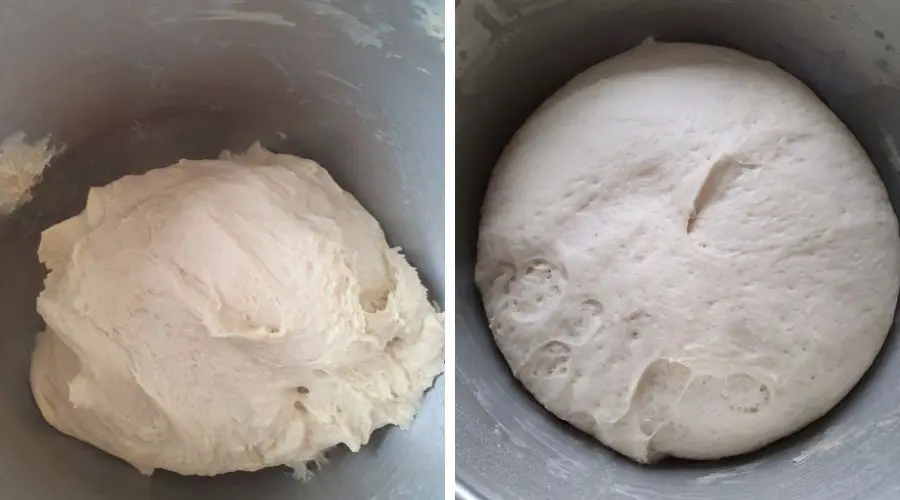
How to prove dough quickly
I always recommend letting the dough rise and prove in its own time, but if you’re tight for time or struggling to get a good rise you might find the following post helpful:
How to Make Bread Dough Rise More Every Time
You might also like…
I hope this post has given you some useful information on proving bread dough along with some tips that you can use when you bake bread at home.
You might also find the following post helpful:
Bread making tips for beginners – Everything you need to know


